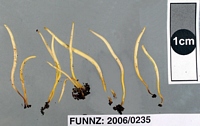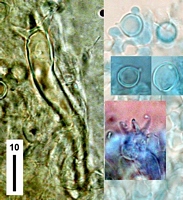|
 Ramariopsis simplex Ramariopsis simplex
BiostatusPresent in region - Indigenous. Non endemic
Images (click to enlarge)
Caption: FUNNZ: 2006/0235, See public note for more information
Owner: FUNNZ | 
Caption: FUNNZ: 2006/0235, See public note for more information
Owner: FUNNZ |
Article: Petersen, R.H. (1988). The clavarioid fungi of New Zealand. New Zealand Department of Scientific and Industrial Research, Bulletin 236: 170 pp. Wellington:.
Description: Fruit bodies up to 7 cm high, up to 4 mm thick, simple clubs, gregarious to subcespitose in small groups (up to 4 individuals). Stipe expanded slightly at base, white below and with a thin covering of appressed white mycelium, equal above, yellow to yellow-orange to ochraceous yellow ('buff yellow"). Club distinct from stipe, expanded somewhat, and then laterally compressed, bright yellow-gold ("apricot-yellow", "light cadmium", "orange-buff", "light orange-yellow"). Apex rounded, often slightly paler than club. Water-soaked fruit bodies fading to pallid ochraceous yellow to yellow-tan. Odour and taste negligible.
Macrochemical reaction: FCL on hymenium negative.
Tramal hyphae nearly uninflated, parallel, clamped. Basidia 75-85 x 7.5-8.5 gm, attenuate-clavate, clamped, uniformly refringent.
Spores 5.9-7.0 x 5.2-6.3 Erin (E =1.00-1.14; E'° =1.10; L'" = 6.5 gm) globose to subglobose, uniguttulate, smooth; hilar appendix prominent, up to 1.5 Erin long, conical.
Notes: Petersen (1979) treated this species under the name Ramariopsis corniculata var. simplex (Donk) Pet. (-Clavaria corniculata f. simplex Donk, Mededeel. Bot. Mus. Utrecht 9:88,1933). At that time I had not examined the type specimen of Donk's taxon, nor had a type been formally designated. Accordingly, I propose the following lectotype specimen: The Netherlands, Valkenburg, Limbourg, x.1900, coll. J. Rick (as Clavaria muscoides), s.n. (L). Examination of that specimen reveals: (i) fruit bodies are branched, although the branches are long and tendril-like, unlike the shorter, more arbuscular form typical of R. corniculata; and (ii) microstructure, including spores, is identical with that of typical R. corniculata. I have concluded that the specimen represents a somewhat aberrant fruit body expression, but well within my concept of the typical form of the species. After disposing of this name, the Pacific fungus remained nameless. Because the epithet simplex is available in Ramariopsis, and is eminently fitting for this species, I have chosen to use it here. In the field, it may be mistaken for Clavaria amoena (elongate spores), Ramariopsis depokensis (ovoid spores, golden-orange fruit bodies), or Clavaria phoenicea in its yellow state (weakly apiculate spores, pastel colours).
|